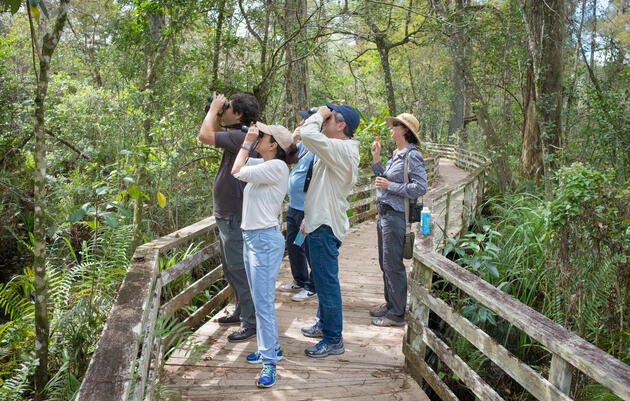UPDATED
Birds are always on the move. For many species, annual migration means crossing entire continents to survive. To protect them from human disturbance, unwise development, and our changing climate, we must know why, how, and where they migrate.
Purple Martins (Progne subis) are long-distance migrants, with most wintering in the Amazon Basin after breeding across the eastern U.S. and Canada. Biologists at the University of Delaware are conducting a study to learn more about Purple Martins. Their goal? To link the movement ecology of individual birds in the mid-Atlantic region with their breeding productivity, foraging habitat use, survival, migration phenology, and nonbreeding locations. The study will also identify the locations and monitor the phenology of autumn Purple Martin roosts in the mid-Atlantic region.
To unlock these mysteries, the team of biologists, led by Jeff Buler, PhD, Professor of Wildlife Ecology at University of Delaware, captured 169 individuals earlier this year and outfitted them with tiny transmitters that communicate with a network of monitoring stations called the Motus Wildlife Tracking System.
The monitoring station receivers collect data from any birds wearing transmitters that pass within several miles. The data is automatically uploaded to a database where researchers can see the exact date and time when their tagged bird moved past the vicinity of a station.
Around the same time the birds were being banded, Audubon staff installed a Motus wildlife tracking station at Corkscrew Swamp Sanctuary. Once migration got underway, the station detected its first bird migrants: Purple Martins, banded by Buler's team.

“Corkscrew Swamp Sanctuary provides important habitat for migrating birds, and this new tool will illustrate even more connections between our habitat and the summer breeding grounds of many species,” says Director of Conservation Marshall Olson. “We're thrilled to contribute to this effort."
According to Buler, the three birds detected at this station in early September included two second-year females and an older male, originating from two different colonies in Delaware.
“It is interesting to see how synchronous their passage was,” Buler said.
As the birds continued their migration, they were tracked by another station in Costa Rica! They are showing us how they connect the dots between our habitats.
By monitoring details about the timing and duration of migratory flights for individual birds of many species, scientists can better understand the timing and seasonal duration of migration. The data also informs land managers about birds’ seasonal habitat preferences, helping our staff learn more about the role the Sanctuary plays as a stopover point or passage for migratory birds while filling knowledge gaps across the broader science community.
And now, data from these tracked birds appear in the Bird Migration Explorer, allowing scientists, birders, conservation enthusiasts, and interested community members to learn more about the birds that live and move through our neighborhoods and natural landscapes.
The Purple Martin banding project is funded primarily by Delaware Audubon with support from Delaware Ornithological Society, Delaware Nature Society, and the Purple Martin Conservation Association.







